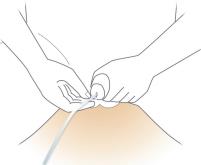From Cure Medical
×
Cure Catheter 16 Inches Male Coude Tip Intermittent Catheter features 100 percent fire polished eyelets and funnel end for males. This sterile, single use catheter is a high quality DEHP, BPA and latex free catheter. Cure Catheter is made with non-carcinogenic materials for safety. View more
Why choose 16 French Coude Catheter?
- Designed for easy open and ease of use
- Fire-polished eyelets for comfortable insertion
- Economical alternative for most popular types of catheters
- Single use
How to use Cure Catheter Male Intermittent Catheter?

- Before you begin, gather the following materials:
- Inspect catheter before use. If catheter or package is damaged do not use.
- Wash hands thoroughly with soap and water, or if not available, use an antibacterial hand cleaner.
- Lay out the equipment so it is within easy reach. Open the water soluble lubricant and catheter package. The Cure Catheter package may open from both ends for ease of use. Apply a liberal amount of lubricant to the tip and first several inches of the catheter.
- Position yourself comfortably. Arrange clothing so it is out of the way. If sitting on the toilet, spread your legs apart. If lying down, knees can be straight or bent.
- Hold the penis upright on the sides so that the urethra is not pinched.
- Retract the foreskin if the penis is uncircumcised. Wash the glans penis from the urethral opening (tip) to the base of the glans with soap, water and washcloth or unscented disposable wipe. Wash with a circular motion from the tip outward. Do not wash back and forth over the urethral opening. Repeat the washing two more times with different areas of the wash cloth or with a new unscented wipe each time.
- While holding the penis upright with one hand at a 45 to 60-degree angle from the body, slowly insert the lubricated catheter into the penis using your dominant hand. Gently slide the catheter until you meet resistance at the urethral sphincters. Do not pull the catheter in and out when you meet resistance; just apply gentle but firm continuous pressure until the catheter advances into the bladder.
- Continue to insert the catheter until urine begins to flow. If you are standing in front of the toilet or sitting on it with legs spread apart, the urine can drain into the toilet. If you are lying down, place the funnel end of the catheter into a container to collect the urine. Hold it in place until urine stops flowing.
- When urine stops flowing, slowly rotate the catheter between your fingers while withdrawing the catheter. If urine starts to flow again when withdrawing the catheter, stop each time it flows and let the urine drain. Continue to slowly withdraw the catheter until the bladder is empty and the catheter is removed. If you are uncircumcised, make sure you bring the foreskin back over the glans penis when you are finished.
- Some men have very tight sphincters or an enlarged prostate which makes it difficult to pass the catheter into the bladder. A catheter with a special, curved (Coude) tip may make passing the catheter easier. If a catheters with Coude tip is needed, your doctor or nurse will show you how to use it.
What is Self-Intermittent Catheterization?
- Intermittent catheterization is the periodic emptying of the bladder by the insertion of a hollow plastic tube (catheter) into the urethra, past the sphincter muscles and into the bladder
- Urine then passes out of the bladder through the catheter
- Intermittent catheterization is used when a person is unable to empty his bladder
- Medical conditions that often require intermittent catheterization include spinal cord injuries, spina bifida and multiple sclerosis, to name a few
- Intermittent catheterization must be done at regular intervals each day to keep the bladder healthy
Customer Reviews
There are no reviews written for this product at the time. Maybe you can be the first!


